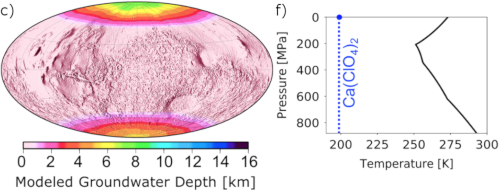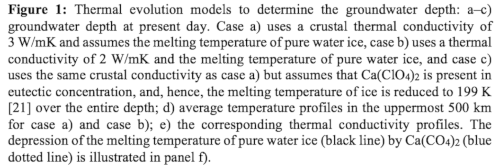Mars' Subsurface Environment: Where to Search for Groundwater?
- 1German Aerospace Center (DLR), Institute of Planetary Research, Berlin, Germany (ana.plesa@dlr.de)
- 2Jet Propulsion Laboratory, California Institute of Technology, Pasadena, CA 91109, USA
- 3Department of Earth, Environmental and Planetary Sciences, Brown University, Providence, RI 02912, USA
- 4Department of Geosciences, University of Padova, Padova, Italy
- *A full list of authors appears at the end of the abstract
While liquid water is not thermodynamically stable at the surface due to the low temperature and pressure conditions, liquid groundwater may still exist in the Martian subsurface [1, 2].
In this study, we use fully dynamical 3D thermal evolution models [3] and 3D parametrized models [4] to calculate the depth at which favorable conditions for liquid water are present, assuming that a global subsurface cryosphere exists on Mars today. While fully dynamical 3D models take into account the effect of mantle plumes self-consistently, they are computationally expensive compared to 3D parametrized models that can cover a large range of mantle conditions, although requiring additional parametrizations for thermal anomalies in the interior. In all calculations, we use a 3D crustal model that is compatible with today’s gravity and topography data [5, 6].
Some of the most important parameters that affect the depth of liquid water are the spatial variations of crustal thickness and crustal thermal conductivity, since the crust has a lower thermal conductivity compared to that of the mantle and thickness variations can shift the groundwater table locally closer to the surface (Fig. 1). The amount and distribution of heat sources, and the presence of mantle plumes, can introduce additional perturbations to the depth of groundwater. The surface temperature distribution and the presence of salts and clathrate hydrates considerably affect the depth and locations where subsurface liquid water may be stable. Hydrated magnesium (Mg) and calcium (Ca) perchlorate salts, whose presence has been suggested at various locations on Mars [7], may significantly reduce the melting point of water ice. In addition to thick regolith layers, clathrate hydrates, if present in the subsurface, would provide an insulating effect reducing the crustal thermal conductivity at least locally [e.g., 8].
The effects of the crustal thermal conductivity and salt abundance on the depth of subsurface liquid water are shown in Fig. 1, where we use the same crustal thickness variations and crustal enrichment in radioactive heat sources in all simulations. The model in Fig. 1a assumes an average crustal conductivity of 3 W/mK, while the model in Fig. 1b has a lower conductivity of only 2 W/mK (see panel 1e for the spatially averaged conductivity profiles that, due to crustal thickness variations, show average values between mantle and crust in the topmost 110 km). Fig. 1d shows the effect of the crustal thermal conductivity on the subsurface temperature profile. For the lower conductivity case the subsurface temperature is warmer, and the groundwater table shifts, on average, 2.5 km closer to the surface. The model shown in Fig. 1c is similar to the one in Fig. 1a but assumes the presence of salts. Instead of using the melting temperature of pure water ice, as was done for the models in Fig. 1a and b, we lower the melting temperature to 199 K [9] over the entire depth, by assuming that Ca(ClO4)2 is present in eutectic concentration (Fig. 1f). This extreme, and unrealistic, assumption places constraints on the minimum depth at which liquid water may be present in the Martian subsurface today, since kinetic factors such as the flow of groundwater due to gravity may increase the depth of the water table, depending on the total amount of liquid water, porosity and permeability.
In Fig. 1a and b, the depth of the groundwater shows the combined effect of crustal thickness distribution and surface temperature variations. Mantle plumes have only a small effect and may introduce perturbations only if the groundwater is located, on average, at about 5 km depth or deeper. The effect of the crustal thickness is evident in basins, along the dichotomy, and in volcanic provinces, whereas surface temperatures give general water table depth trends with latitude. In Fig. 1c, the depth variations of the groundwater table are mainly caused by the surface temperature distribution, as the groundwater table is located very close to the surface (between 0 – 1 km for latitudes between -57° and 57°). Nevertheless, in all cases (Fig. 1a – c), the water table is significantly shallower in equatorial regions compared to polar regions, mainly governed by lower surface temperatures at the poles.




Our results suggest that the Martian subsurface has had, and still has, the potential to enable deep environments with stable liquid groundwater. Combined with the analysis of geomorphological features at the Martian surface that testify the involvement of water/ice activity and maps of subsurface water ice [10], such models could provide valuable estimates of the depth of liquid groundwater on past and present-day Mars providing key knowledge on the planet dynamics, evolution and astrobiological potential.
The technology to probe the Martian subsurface at depths of many kilometers is maturing [2]: TH2OR (Transmissive H2O Reconnaissance), a low-mass and average low-power transient electromagnetic sounder capable of detecting the presence of liquid water to depths of many kilometers is currently being developed at JPL [11]. Moreover, mission concepts such as VALKYRIE (Volatiles And Life: KeY Reconnaissance & In-situ Exploration) [12], which would add to the liquid water sounder a drill capable of accessing depths of 10s-100s of meters or more and employ a (bio)geochemical analysis package on the surface, would provide the measurements necessary to characterize the modern-day subsurface habitability of Mars.
References: [1] Clifford et al., 2010, JGR, 115(E7); [2] Stamenković V. et al., 2019, Nat. Astron., 3(2); [3] Plesa A.-C. et al., 2018, GRL, 45(22); [4] Breuer D. & Spohn T., 2006, PSS, 54(2); [5] Plesa A.-C. et al., 2016, JGR, 121(12); [6] Wieczorek M. & Zuber M., 2004, JGR, 109(E8); [7] Leshin L. et al., 2013, Science, 341; [8] Kargel J. et al. 2007, Geology, 35(11); [9] Marion G. et al., 2010, Icarus, 207(2); [10] Piqueux S. et al., 2019, GRL, 46.; [11] Burgin M. et al., 2019, AGU Fall Meeting, P44B-02; [12] Mischna M. et al., 2019, AGU Fall Meeting, P41C-3466.
Acknowledgments: This work was performed in part at the Jet Propulsion Laboratory, California Institute of Technology, under contract to NASA. © 2020, California Institute of Technology.
Mariko Bürgin, Robert Grimm, Nathan Barba, Raju Manthena, Kalind Carpenter, Charles Edwards, Patrick McGarey, Seth Krieger
How to cite: Plesa, A.-C., Stamenković, V., Breuer, D., Hauber, E., Tarnas, J., Mustard, J., Mischna, M., and De Toffoli, B. and the TH2OR and VALKYRIE Teams: Mars' Subsurface Environment: Where to Search for Groundwater?, Europlanet Science Congress 2020, online, 21 September–9 Oct 2020, EPSC2020-698, https://doi.org/10.5194/epsc2020-698, 2020

